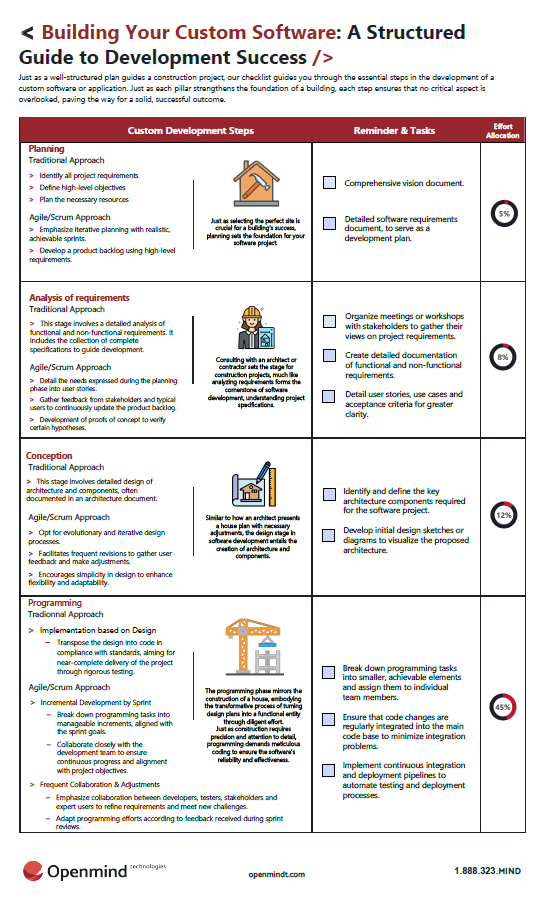Easily track the 7 product development steps
Navigate clear steps with reminders, tasks, and documented effort percentages for each stage with our handy free checklist.

Do you have an idea for an app, and want to make an IT project out of it? There are, of course, several steps to complete before an IT project can see the light of day, and above all, before it can become a true success. Since app IT projects require a significant investment, it is reassuring when you are fully equipped to make the right decisions for your technology product’s design and success.

Naturally, analysis is the first step of an IT project, because it brings together all of the preliminary information for evaluating the feasibility and potential of your technology product on the market.
Here are a few points that need to be clarified:

Easily track the 7 product development steps
Navigate clear steps with reminders, tasks, and documented effort percentages for each stage with our handy free checklist.


This second step of an IT project is when you use information gathered in the first step to define the scope of the project, the technical requirements/user experience (Design UX/UI) and the amount of time that will be necessary to complete it. Since you will need to work with a technology partner to develop your app, this step of the IT project will primarily help you better understand the technical requirements and the corresponding technical and financial risks.

This step of an IT project is often the one that allows you to actually develop your technology product. Since you will need to contract with an external firm to develop your product, a significant amount of money will be necessary. However, financial backing could give you the boost you need to bring your project to fruition. Here are some of the solutions available in the innovation and technology industry:
Government grants/tax credits: There are different government programs and services that provide financial aid to innovative companies.
Financial partners: Financial institutions like the BDC and Investissement Québec provide financial products specifically designed to back innovative projects.
Private investors: There are organizations with private investors looking to fund start-up companies in the innovation and technology industry.
Securities crowdfunding: This solution allows companies to obtain financing in exchange for company bonds or shares.

The steps of an IT project, in the development of a technology product, must allow you to create value as soon as possible. You should prioritize the MVP (minimum viable product) for the following reasons:

This step – introducing your product to your customer base – will likely determine how soon you will see a return on your investment. Nevertheless, to penetrate a market where the competition is already well established, you’ll need to use the best marketing strategies available, the ones most suitable your product’s market launch.
Here are some of our best practices:
These strategies will allow you to verify your previously defined metrics and to make adjustments based on the results.

Once the product is in the market, you can refer to user-generated metrics and feedback. This will enable you to test your hypotheses, and to do one the following:
It’s clear that transforming a good idea into a viable technology product comes with its own set of unknowns and risks. Is your technology partner telling you that everything is possible, and to not worry about a thing? Beware! Surround yourself with partners who can give you objective advice, and who will support you in the creation of key metrics to minimize your level of risk. Finally, choose professionals who can guide you through all the steps of your technology project with transparency, and who will give you an accurate picture of the situation, so you can make the right strategic decisions.
Not sure where to begin with your IT project? Let’s connect and get you on the right track.

Tell us more about your needs so that we can better route your project to our specific SWAT team.
1
During the brainstorming phase, we work with you to identify potential solutions to your business challenges to generate the technology response that aligns with your business objectives.
2
Through our requirements gathering process, we work closely with you to define and prioritize your needs, ensuring that our solutions are tailored to meet your specific requirements.
3
This phase marks the beginning of our partnership. We’ll finalize the project plan and establish clear communication channels to ensure a smooth and successful project execution.